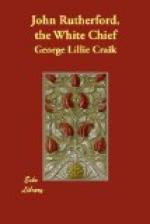“We were then taken to Aimy’s house, which was the largest in the village, having the walls formed of large twigs covered with rushes, with which it was also thatched. A pig was now killed for us, and cooked with some coomeras, from which we supped; and, afterwards seating ourselves around the fire, we amused ourselves by listening to several of the women singing.
“In the meantime, a slave girl was killed, and put into a hole in the earth to roast in the manner already described in order to furnish a feast the following day, in honour of the chief’s return home.
“We slept that night in the chief’s house; but the next morning a number of the natives were set to work to build one for ourselves, of the same form with that in which the chief lived, and nearly of the same size.
“In the course of this day, many other chiefs arrived at the village, accompanied by their families and slaves, to welcome Aimy home, which they did in the usual manner. Some of them brought with them a quantity of water-melons, which they gave to me and my comrade. At last they all seated themselves upon the ground to have their feast; several large pigs, together with some scores of baskets of potatoes, tara, and water-melons, having first been brought forward by Aimy’s people. The pigs, after being drowned in the river and dressed, had been laid to roast beside the potatoes. When these were eaten, the fire that had been made the night before was opened, and the body of the slave girl taken out of it, which they next proceeded to feast upon in the eagerest manner. We were not asked to partake of it, for Aimy knew that we had refused to eat human flesh before. After the feast was over, the fragments were collected, and carried home by the slaves of the different chiefs, according to the custom which is always observed on such occasions in New Zealand.”
The house that had been ordered to be built for Rutherford and his companion was ready in about a week; and, having taken up their abode in it, they were permitted to live, as far as circumstances would allow, according to their own customs. As it was in this village that Rutherford continued to reside during the remainder of the time he spent in New Zealand, we may consider him as now fairly domesticated among his new associates, and may therefore conveniently take the present opportunity of completing our general picture of the country and its inhabitants, by adverting to a few matters which have not yet found a place in our narrative.
No doubt whatever can exist as to the relationship of the New Zealanders to the numerous other tribes of the same complexion, by whom nearly all the islands of the South Sea are peopled, and who, in physical conformation, language, religion, institutions, and habits, evidently constitute only one great family.




